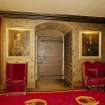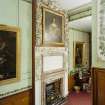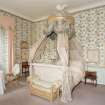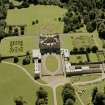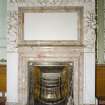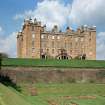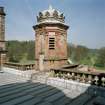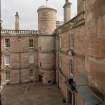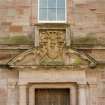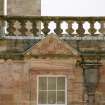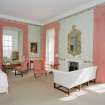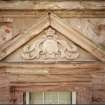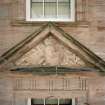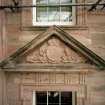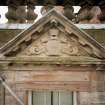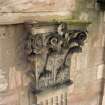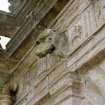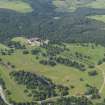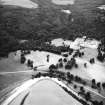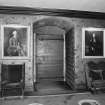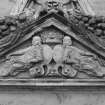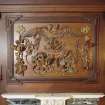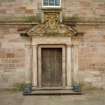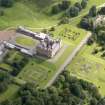Pricing Change
New pricing for orders of material from this site will come into place shortly. Charges for supply of digital images, digitisation on demand, prints and licensing will be altered.
Upcoming Maintenance
Please be advised that this website will undergo scheduled maintenance on the following dates:
Thursday, 9 January: 11:00 AM - 3:00 PM
Thursday, 23 January: 11:00 AM - 3:00 PM
Thursday, 30 January: 11:00 AM - 3:00 PM
During these times, some functionality such as image purchasing may be temporarily unavailable. We apologise for any inconvenience this may cause.
Drumlanrig Castle
Country House (16th Century), Hospital (First World War)
Site Name Drumlanrig Castle
Classification Country House (16th Century), Hospital (First World War)
Alternative Name(s) Drumlanrig Policies; Drumlanrig Estate; Drumlanrig Auxiliary Hospital
Canmore ID 65142
Site Number NX89NE 1
NGR NX 85190 99214
Datum OSGB36 - NGR
Permalink http://canmore.org.uk/site/65142
First 100 images shown. See the Collections panel (below) for a link to all digital images.
- Council Dumfries And Galloway
- Parish Durisdeer
- Former Region Dumfries And Galloway
- Former District Nithsdale
- Former County Dumfries-shire
(NX 85179921) Drumlanrig Castle (NAT)
OS 6" map (1957)
NX89NE 1.00 85190 99214 Drumlanrig Castle
NX89NE 1.01 85159 99126 Garden
NX89NE 1.02 85072 99554 1 Laundry Cottages
NX89NE 1.03 85 99 Mallyford Cottage
NX89NE 1.04 87375 97463 Dabton House
NX89NE 1.06 85950 99923 Bridge Cottage, (Gate lodge)
NX89NE 1.07 85762 98206 Low Gardens House
NX89NE 1.08 85343 99151 Drumlanrig Estate, Gardener's Cottage
NX89NE 1.09 85342 99134 Drumlanrig Estate, Glass House
NX89NE 1.10 87269 97300 Dabton House Lodge and Gatepiers
NX89NE 1.11 87419 97511 Dabton House Stables
NX89NE 1.12 87492 97575 Dabton Walled Garden
NX89NE 1.13 85451 98193 Drumlanrig Estate, Chimney
NX89NE 1.14 85945 98305 Drumlanrig Estate, Walled Garden
NX89NE 1.15 85608 98558 Drumlanrig Estate, Heather House
NX89NE 1.16 85076 99562 2 Laundry Cottages
NX89NE 1.17 85212 99247 Drumlanrig Castle, East Courtyard range
NX89NE 1.18 85157 99305 Drumlanrig Castle, West Courtyard Range
NX89NE 1.19 85112 99307 Drumlanrig Castle, Stables
NX89NE 1.20 85170 99196 Sundial
See also
NX89NE 28 8486 9910 Drumlanrig Estate, Heather House (Folly, Viewing platform)
NX89NW 40 84356 98721 Drumlanrig Estate, Summer House
NS80SE 55 85172 00056 Drumlanrig Estate, Cottages
NS80SE 56 85233 00087 Drumlanrig Estate, House
NS80SE 57 8525 0047 Kennels
NS80SE 58 8524 0042 Cottage
NS80SE 59 9584 0003 Cottage
NS80SE 83 85565 00540 Creel Bridge (River Nith)
NS80SE 89 85172 00061 Cottage
NS80SE 93 85229 00353 Drumlanrig Park (house)
NMRS REFERENCE:
Architect: William Luckup, Master Mason c.1685
James Smith or Robert Mylne - 1679-1690
Peter P Boyse and Cornelius Van Nerven - carved entrance front
William Atkinson - scheme for rebuilding - 1812
Edward Blore - design for alterations c.1818
Peregrine Cust - scheme for rebuilding - 1827
William Burn - alterations and additions - 1830
William Elliot - alterations - 1813
11th Earl of Mar - designs for remodelling - (S.R.O. GD/24/V 28,29,30)
Sir Charles Barry - design for layout of house and garden
Remodelled from an earlier building in 1679-90, Drumlanrig Castle is one of the great courtyard houses, showing a combination of castellated and Renaissance styles.
Tradition says there were two previous buildings on the site, but the earliest mention of the castle is in 1492, although the Douglases had held the barony since 1356.
Traces of the former building are found in the cellar in the SE corner and in two fragmented ?16th century gun-loops built into the east wall of the castle. There are also three iron 'yetts'.
J G Dunbar 1966; C T Ramage 1876; RCAHMS 1920; J Williams 1968
Drumlanrig Castle (name verified) (Mr Kennedy, Queensberry Estates, Thornhill) is as described and planned. (Buccleuch Estates Ltd 1976) Visited by OS (TRG) 31 August 1977
Photographed by the RCAHM in 1980.
Inventory to Buccleuch Drawings (at Drumlanrig) - typescript
EXTERNAL REFERENCE:
Drumlanrig Muniment Room:
Drawer L, Nos 1105-11 - Accounts regarding work carried out by Wm. Elliot 1813
Wooden Chest No 5 - Papers regarding the rebuilding of the south block 1618-1622
R.I.B.A. Drawings Collection:
Charles Barry - perspective layout of house and garden
Edward Blore - 9 plans showing alterations c.1818
Scottish National Portrail Gallery:
Country Life, August 23rd, 1902 - article and photographs
Country Life, August 22nd 1947, p378 - article and photographs
Country Life, July 28th, 1928
Country Life, Sptember 7th, 1935 - article and photographs
Scottish Record Office:
RHP 9456 David Lowe, gardener 1738 - plan of house and gardens
RHP 9458, 9459 Wm. and David Crawford 1817, 1818 - estate plans
RHP 9677/1-79 Peregrine Cust 1827 - plans for scheme for rebuilding
William Atkinson 1812 - plans of proposed alterations for castle
Charles Barry 1841 - plans for proposed alterations
Edward Blore c.1818 - plans and elevations for alterations
RHP 13256 Nos 66, 67 & 1722 - Earl of Mar's Drawings - drawing
Account for-
Quarry and quarrystone for pavement in the House of Drumlanrig.
A wall in the Low entry
Stack of vents on the West side of house.
Renewing roof of SW turnpike
Making part of new road through the lower? park by the outside of the new enclosure.
Making laundry.
1756-1757 £55.4.8 GD103/2/399
Letters from Charles D of Queensberry and James Fergusson of Craigdarroch
concern damage done by the rebels during their stay at Drumlanrig.
1745-1746 GD 77/209
Account of work done on estate. It includes paving, making vents, a laundry
and renewing the roof of the turnpike.
1756-57 GD 103/2/399
Letters, John Smallwood, architect to the Duke of Buccleuch regarding building
works at Drumlanrig Castle. (23 items)
1816-19 GD 224/668/3
Accounts and letters, etc., relating to alleged overcharging and defective
workmanship by William Hayland, plumber, Dumfries, in relation to plumbing
work done by him at Drumlanrig Castle (installation of lead pipes, water closets).
12 items GD 224/519/6
Drumlanrig estate: miscellaneous letters and papers. (Some relate to
Drumlanrig Castle repairs. The 1772 item is a description of the course of the
lead pipework in the castle).
GD 224/518/3
Accounts of mason days at Cascade and Damhead from 1st June 1736 - 7th October 1736.
Building the walls of the aqauduct, pavementing the same and building and
pavementing the walls at Damhead etc. Thomas Mein, principal mason. Account
workmens' days and wages at the Cascade, November 1st 1735 - 1st March 1736.
Photographic Survey (November 1961)
Photographic survey by the Scottish National Buildings Record/Ministry of Work in November 1961
Publication Account (1986)
This grand mansion stands upon a terraced platform among the woods of upper Nithsdale, its four-square turreted profIle and pink-coloured sandstone contrasting with the greenery of its surroundings. Completed in about 1690, Drumlanrig became the home of James Douglas, 2nd Duke of Queensberry, known as the 'Union Duke' because of his role in the Treaty of Union of 1707. During these negotiations Daniel Defoe acted for Harley of Queen Anne's government; at Drumlanrig he was impressed by 'a palace so glorious, gardens so fine, and everything so truly magnifIcent ... all in a wild, mountainous country, the like we had not seen before', but which in some respects reminded him of Derbyshire.
The builder of this noble pile was lames's father, William, 3rd Earl and (from 1684) 1st Duke of Queensberry; he died in 1695 ruined, it is said, by the expense it had incurred. The design that he adopted in 1679 was basically one that had been presented to his grandfather in 1618. The layout followed that of Heriot's Hospital, Edinburgh, and was probably by the same accomplished mason-architect, William Wallace. By 1679, however, Classicism was the order of the day. The central part of the entrance front thus has two storeys of pedimented windows framed within pilasters of a giant Corinthian Order; a central projecting entrance-porch is similarly treated, and rises to a clock-lantern which wears a ducal coronet. The entry is on a terrace above an arcaded basement, and is approached by a double circular staircase.
The architect was almost certainly lames Smith, who had been a mason at Holyroodhouse under Sir William Bruce and Robert Mylne (d. 1710). In 1683,during the Drumlanrig campaign and on the recommendation of the earl, he was appointed overseer of the Royal Works in Scotland in succession to Bruce. It is thus not surprising that Drumlanrig's frontispiece should owe much to Bruce's west front at Holyroodhouse, and that in his first known design Smith should be uncertain in his handling of the elements of Classical architecture. However, the seeds of his architectural career may have been sown during earlier travels in Italy, and this may simply be the faltering first step of the father of British Palladianism. The Master of Works was William Lukup, who is represented with the tools of his trade on a carved headstone of1685 in Durisdeer churchyard (no. 62).
Externally homogeneous, parts of the structure, especially the thick-walled eastern quarter, probably incorporate much of the old medieval castle, which by 1618 had assumed an iiregular quadrangular layout. James Douglas (d. 1578) is credited with its completion in this form, but its origins probably go back beyond 1429 when the castle first comes on record. The barony itself was in the possession of the Douglases from about 1357 until 1810, when upon the death of the 4th Duke, the title and most of the estates passed to the 3rd Duke ofBuccleuch, grandson of Lady Jane Douglas, daughter of the 'Union Duke'.
The succession of the Scotts of Buccleuch marks a watershed in the history of Drumlanrig, for the 3rd Duke's descendants (especially the 5th Duke, the 7th Duke of Queensberry, d. 1884) carried out much needed programmes of restoration, giving the house the careful treatment normally accorded an old master. Service wings were added on each side of the forecourt and were designed with restraint and sympathy, probably by William Bum who came to enjoy much patronage from the 5th Duke at his other properties.
Also thanks to the Buccleuchs, the contents of Drumlanrig have become a veritable 'treasure house', representing parts of three family collections with imports from former residences elsewhere; Rembrandt's masterpiece, 'An Old Woman Reading' (1655), must be one of the more prized items. Imported plenishings include at least one carved overmantel by the celebrated Grinling Gibbons. Most of the wood carving and panelling was installed in existing positions in the 1930s.
An inventory of1694 describes the internal arrangements and fittings of the newly completed mansion. The main entrance was then on the inner face of the south range, reached through an open arcade in the north range, now the front hall. At this level the south range had a 'low' dining-room, later enlarged, and a drawing-room, later converted to a serving-room. Vertical circulation was only by the newel stairs in the re-entrant angles of the courtyard, but the open-well wooden staircase was completed shortly afterwards in 1697. The great drawing-room on the first floor of the south range was originally the state dining-room, the ante-room on the west having been the principal drawing-room; the adjacent room, where Bonnie prince Charlie slept in December 1745, still possesses the painted overmantel described in 1694 as 'ye history of Hercules and ye dragon'.
Great formal gardens were laid out as a fitting complement to the house. On the south front there are original staircases with scrolled wrought-iron balustrades, and the landing of the main double stair stands above a columned pavilion. In 1721 Sir John Clerk was much impressed by the gardens, 'excellently laid out in the newest fashion with parterres, terraces, sloping banks, wildernesses, hedges, water works, etc., and the Duke keeps daily at work a gardener and 26 men to dress them'. The 3rd Duke of Queensberry created a lake and a cascade, and busied himself with tree planting. By 1772 Drumlanrig had become 'embosomed in trees', and the ascent to it was through 'a fine and well-planted park'.
Unfortunately, in 1786 the trees were devastated 'by an uncommonly high wind', and then by the 4th Duke, who had almost the whole of the surrounding woodlands cut down. Tree planting recommenced after 18lO, and great progress with the formal gardens was made in the 1830s when they were laid out in accordance with the pattern shown on old drawings. A few years later the parish minister was able to write that 'every facility is afforded to strangers to gratity their curiosity here [ie. in the greenhouses and vegetable garden], or in the lovely flower gardens in the immediate vicinity of the castle'.
Information from ‘Exploring Scotland’s Heritage: Dumfries and Galloway’, (1986).
Project (March 2013 - September 2013)
A project to characterise the quantity and quality of the Scottish resource of known surviving remains of the First World War. Carried out in partnership between Historic Scotland and RCAHMS.











































































































